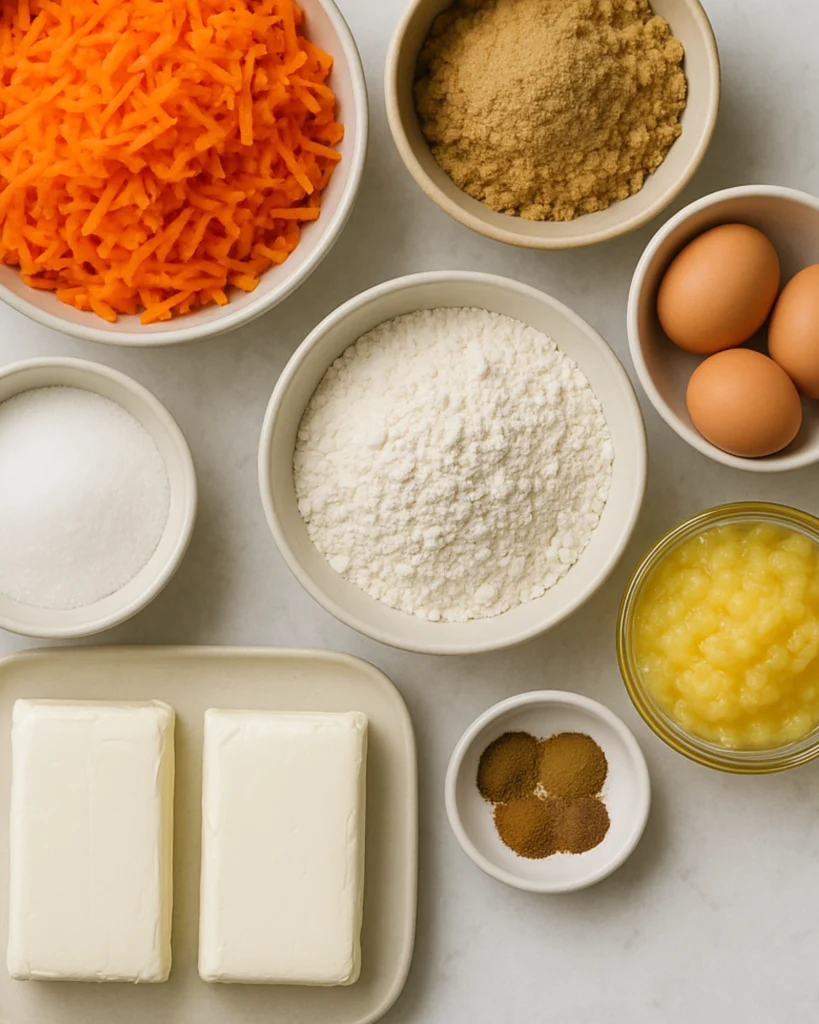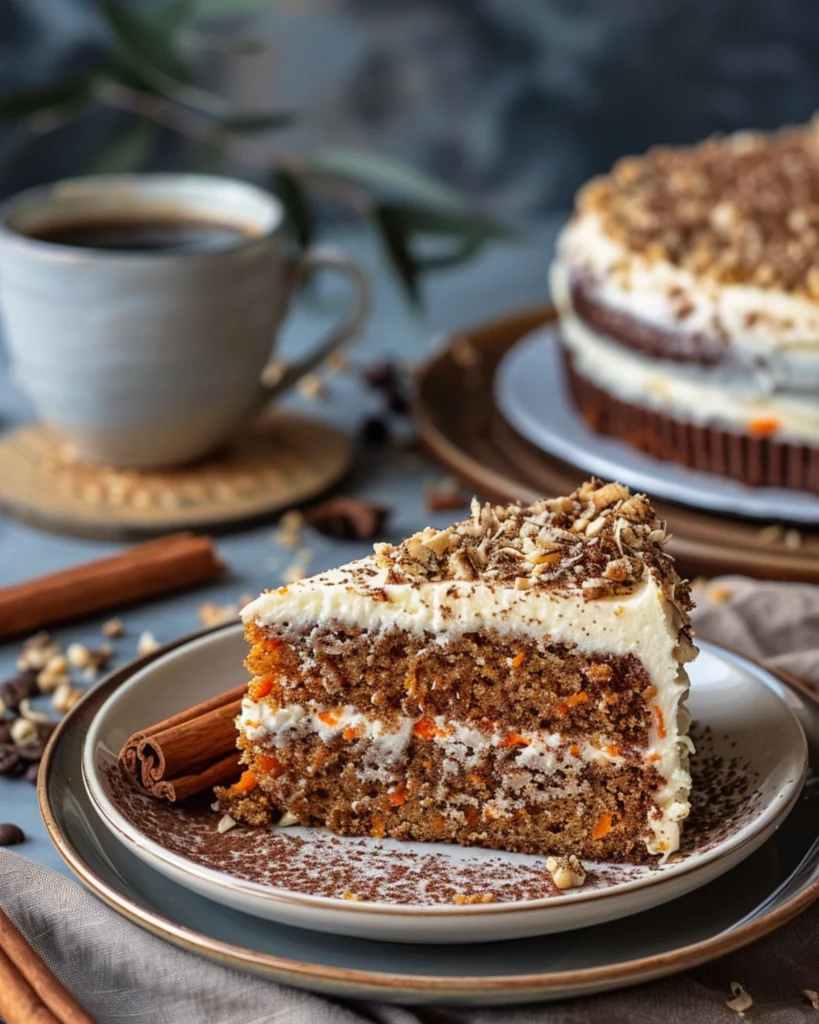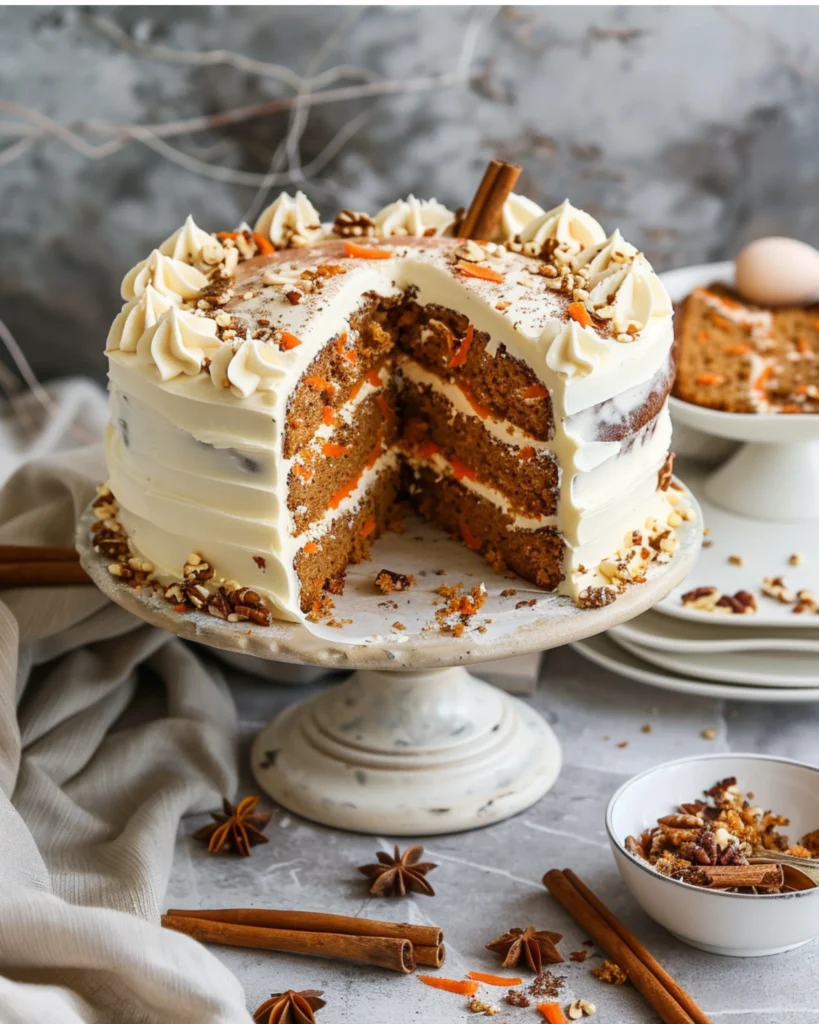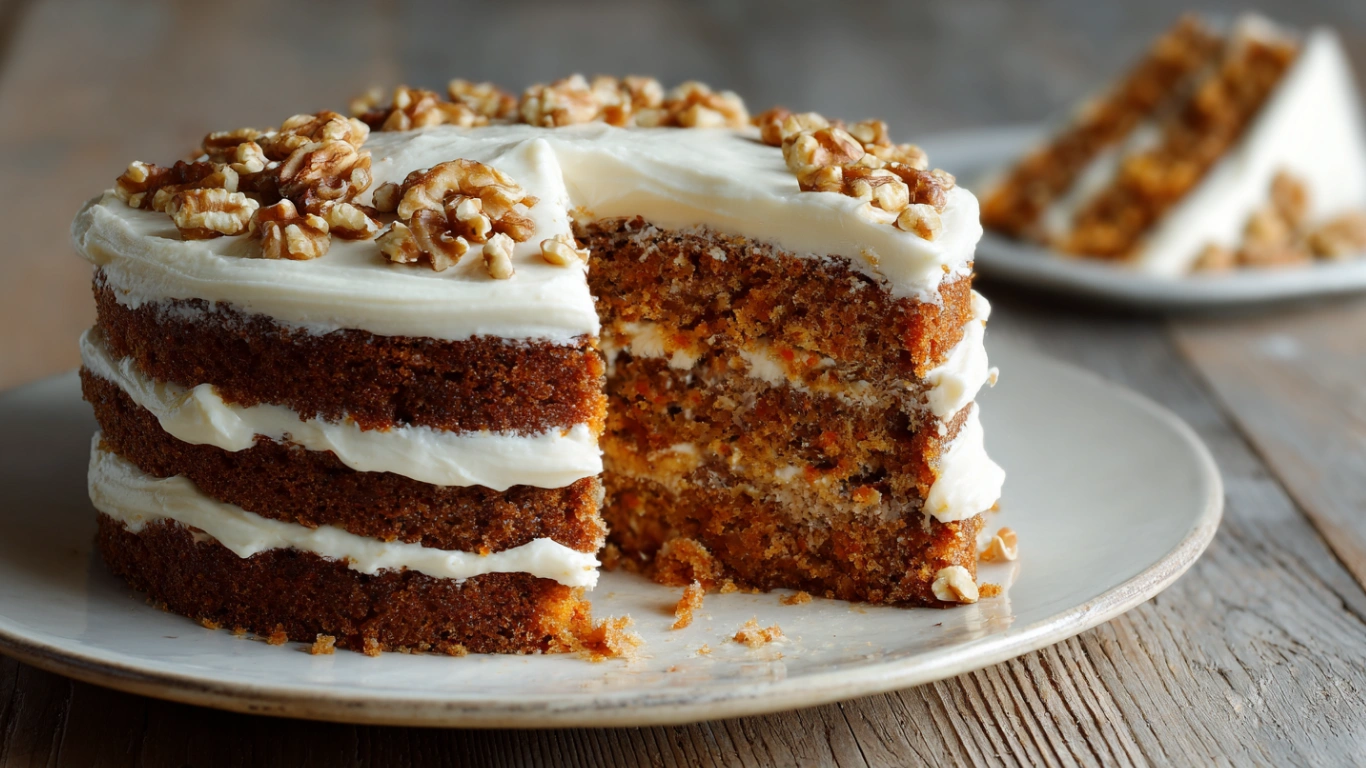arrot cake is one of those classic desserts that never goes out of style. In this article, I’ll walk you through everything that makes a carrot cake truly irresistible, from ingredient secrets to why cream cheese frosting is its perfect match. You’ll learn the techniques, variations, and answers to common questions like whether Philadelphia cream cheese works best, and what makes this dessert so beloved.
Table of Contents
The Story Behind the Best Carrot Cake with Cream Cheese
Baking memories that never fade
Carrot cake has always had a special place in my heart. I remember the first time I baked it with my grandmother, it was a chilly autumn day, and the warm scent of cinnamon and vanilla filled the kitchen as we grated fresh carrots by hand. She believed the secret to the best carrot cake wasn’t just the ingredients, it was patience, care, and that creamy, tangy layer of cream cheese frosting that brought it all together. It’s that nostalgic experience that inspired me to perfect my own version of this timeless dessert.
When it comes to baking an irresistible carrot cake with cream cheese, the magic lies in balancing moisture and flavor. Carrots provide a natural sweetness and texture, while crushed pineapple, oil, and a pinch of nutmeg elevate the richness. But what truly transforms the cake is the frosting. Cream cheese isn’t just good on carrot cake—it’s essential. It softens the spice, adds tang, and gives that dreamy mouthfeel we all crave.
Prefer something cooler? Try an iced cinnamon almond milk latte or a chilled spiced herbal tea, both pair beautifully with the warm spices in carrot cake. Looking for more wholesome ideas? Explore these healthy recipe collections from BBC Good Food featuring balanced dishes and better-for-you desserts.
Why cream cheese matters in carrot cake
Cream cheese frosting isn’t just an afterthought, it’s the reason many people choose carrot cake in the first place. Cream cheese brings a bold, slightly tangy contrast to the warm spices of the cake, balancing out the sweetness beautifully. Its creamy consistency also locks in moisture, keeping every bite tender for days.
You might wonder: can I use Philadelphia cream cheese for carrot cake? Absolutely. In fact, it’s one of the most reliable options. It’s smooth, richly flavored, and holds up well whether you’re piping swirls or spreading a thick, rustic layer. It’s the kind of finishing touch that makes people ask for seconds—and the recipe.
Next, we’ll dive into crafting the perfect carrot cake texture.
How to Achieve the Perfect Carrot Cake Texture
Moist but not soggy: the sweet spot
One of the biggest challenges when making carrot cake is getting the texture just right. You want it incredibly moist, but not wet. Soft, but not mushy. That perfect balance comes down to how you prepare and measure your ingredients, and what you leave out.
Start with finely grated carrots. Thick shreds won’t soften enough during baking and can leave stringy bits in the cake. If possible, grate your carrots by hand using the small holes on a box grater. It takes a bit more effort, but the result is worth it. Next, avoid overmixing the batter. Once the dry ingredients are combined with the wet, mix just until everything is incorporated. Overmixing can create gluten, which makes the cake tough instead of tender.
Also, swap butter for oil in carrot cake. Oil creates a richer, more evenly moist crumb. Some bakers worry oil makes the cake greasy, it doesn’t, if you measure properly. Typically, you’ll use one cup of oil for every 2–2.5 cups of flour. Add crushed pineapple or applesauce for a naturally sweet and moist boost. Just be sure to drain the pineapple to avoid excess liquid.
Baking temperature makes a difference
If you’ve ever had a carrot cake that turned out heavy, chances are it was baked too hot or too long. A moderate oven temperature—around 325°F—is key. This gives the batter enough time to rise and set without drying out. Always check for doneness with a toothpick in the center; it should come out with a few moist crumbs, not raw batter.
And don’t skip resting the cake. Once out of the oven, allow it to cool in the pans for 10–15 minutes before turning it out. Letting it fully cool before frosting ensures that the cream cheese topping glides on beautifully without melting.
Frosting Secrets: Getting Cream Cheese Just Right
The secret to silky, tangy frosting
Cream cheese frosting is the heart of a great carrot cake. But not all cream cheese frostings are created equal. The best ones are smooth, tangy, and firm enough to hold their shape, whether you’re spreading a rustic layer or piping decorative swirls.
Always start with full-fat brick-style cream cheese. Tub-style or whipped cream cheese is too soft and won’t create a stable frosting. Leave both the cream cheese and butter out at room temperature for 30–60 minutes so they soften evenly. This prevents lumps when mixing and helps everything blend into a smooth, fluffy consistency.
The basic ratio? Use 1 cup (2 sticks) of unsalted butter to 16 oz (two blocks) of cream cheese. Add 4 cups of powdered sugar gradually while mixing on medium speed. A touch of vanilla extract enhances flavor, and if your frosting feels too soft, chill it briefly before applying.
Some bakers prefer adding lemon juice or zest to sharpen the flavor. That works especially well when layering the cake or pairing it with fruity elements like pineapple. For variations, you can also experiment with maple syrup or brown sugar for a deeper, caramel-like flavor.
You’ll find this technique works beautifully in our best banana bread recipe where moisture is key, or the strawberry shortcake cake mix version which uses creamy toppings for a balanced finish.

Common frosting issues (and how to fix them)
If your frosting turns runny, chances are the ingredients were too warm, or it was overmixed. To recover it, refrigerate for 20 minutes, then gently mix again. If it’s still too soft, add 1–2 tablespoons of cornstarch or more powdered sugar. On the other hand, if it’s stiff or lumpy, try letting it warm slightly and whip again.
And remember: don’t frost a warm cake. Patience pays off. Wait until your layers are completely cooled to prevent melting or sliding.
Serving Ideas and Perfect Pairings
Best ways to serve carrot cake (beyond birthdays)
Carrot cake isn’t just for special occasions, it’s perfect for any time you want something comforting and delicious. It can be served as a classic layer cake, in sheet pan form, or even baked into cupcakes for easy sharing. Once your carrot cake is frosted and chilled slightly, it slices beautifully into neat, clean portions. For that extra professional look, dip your knife in hot water before slicing.
For more indulgent presentation, top the cake with toasted pecans, candied carrots, or a sprinkle of cinnamon. Some people love decorating with crushed walnuts or dried pineapple for added flavor and texture. Carrot cake also holds well in the fridge, just cover it tightly and it’ll stay moist and flavorful for up to five days.
If you’re preparing for a gathering, slice and plate ahead, then garnish each piece with a dollop of whipped cream or even a scoop of vanilla bean ice cream. It’s an easy upgrade that makes the cake feel like a full dessert experience.

What to pair with carrot cake (drinks & more)
The richness of carrot cake with cream cheese frosting makes it ideal for pairing with drinks that either contrast or complement its flavors. A lightly brewed chai latte, for example, brings out the spices in the cake without overpowering them. Black coffee is another simple, effective pairing, especially if you enjoy balancing sweet with bitter.
Prefer something cooler? Try an iced cinnamon almond milk latte or a chilled spiced herbal tea. If you’re feeling celebratory, a sweet Riesling or sparkling Moscato works beautifully. Want to go non-traditional? This guide to dessert wine pairings offers creative options for carrot cake lovers seeking something extra special.
No matter how you serve it, one thing’s for sure, carrot cake with cream cheese will never go out of style.


Carrot Cake with Cream Cheese Frosting
Ingredients
Equipment
Method
- Preheat oven to 325°F. Grease and flour two 9-inch round pans.
- In a bowl, mix oil, sugars, eggs, vanilla, and pineapple until smooth.
- Add grated carrots and stir until evenly distributed.
- In another bowl, whisk flour, baking soda, cinnamon, nutmeg, and salt.
- Gradually mix dry ingredients into wet mixture until just combined.
- Fold in walnuts if using. Divide batter between pans.
- Bake for 35–40 minutes or until toothpick comes out with moist crumbs.
- Cool for 15 minutes in pans, then remove and cool completely.
- Beat cream cheese and butter until smooth. Add powdered sugar and vanilla, whip until fluffy.
- Frost cooled cakes and chill for at least 30 minutes before serving.
Nutrition
Notes
From your stove to our hearts
share your delicious take!Frequently Asked Questions
Can you use Philadelphia cream cheese for carrot cake?
Yes, Philadelphia cream cheese is ideal. It’s smooth, flavorful, and perfect for creating thick, creamy frosting that holds its shape.
What does cream cheese do to a cake?
Cream cheese enhances flavor, adds moisture, and creates a smooth, stable frosting that elevates the cake’s texture and richness.
Is cream cheese good on carrot cake?
Yes, cream cheese adds tangy richness and balances the cake’s sweetness, making it the perfect pairing for carrot cake.
What is the secret to the best carrot cake?
Use finely grated carrots, oil, and crushed pineapple for moisture. Bake at a low temperature and avoid overmixing to keep the cake soft and flavorful.
Conclusion
There’s something timeless about an irresistible carrot cake with cream cheese. It’s not just the flavor—it’s the texture, the memories, the warmth in every bite. With finely grated carrots, a perfectly spiced batter, and rich, velvety frosting, this dessert brings comfort and celebration together on one plate.
Whether you’re baking it for a birthday, brunch, or just because you need something sweet, this cake never disappoints. And with the simple tips shared here—from ingredient choices to frosting fixes—you’ll be equipped to make a version that’s moist, flavorful, and absolutely unforgettable.
Now it’s your turn to bake, slice, and share. Because the best recipes aren’t just followed—they’re felt, remembered, and passed dow
